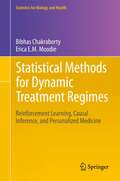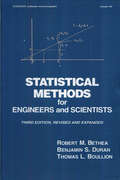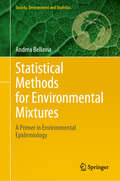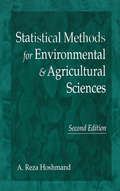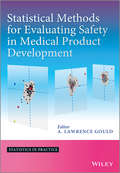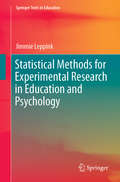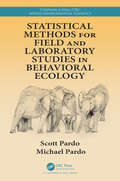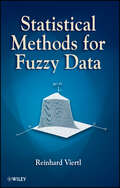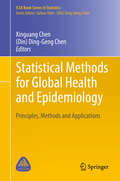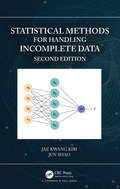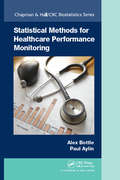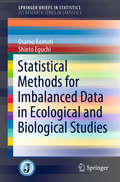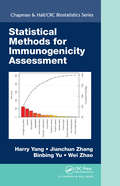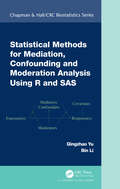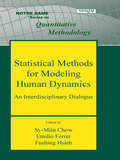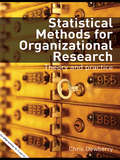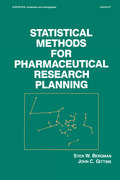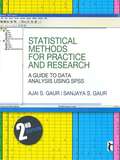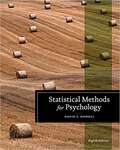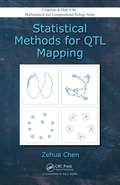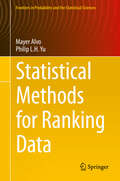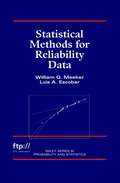- Table View
- List View
Statistical Methods for Dynamic Treatment Regimes: Reinforcement Learning, Causal Inference, and Personalized Medicine
by Bibhas Chakraborty Erica E.M. MoodieStatistical Methods for Dynamic Treatment Regimes shares state of the art of statistical methods developed to address questions of estimation and inference for dynamic treatment regimes, a branch of personalized medicine. This volume demonstrates these methods with their conceptual underpinnings and illustration through analysis of real and simulated data. These methods are immediately applicable to the practice of personalized medicine, which is a medical paradigm that emphasizes the systematic use of individual patient information to optimize patient health care. This is the first single source to provide an overview of methodology and results gathered from journals, proceedings, and technical reports with the goal of orienting researchers to the field. The first chapter establishes context for the statistical reader in the landscape of personalized medicine. Readers need only have familiarity with elementary calculus, linear algebra, and basic large-sample theory to use this text. Throughout the text, authors direct readers to available code or packages in different statistical languages to facilitate implementation. In cases where code does not already exist, the authors provide analytic approaches in sufficient detail that any researcher with knowledge of statistical programming could implement the methods from scratch. This will be an important volume for a wide range of researchers, including statisticians, epidemiologists, medical researchers, and machine learning researchers interested in medical applications. Advanced graduate students in statistics and biostatistics will also find material in Statistical Methods for Dynamic Treatment Regimes to be a critical part of their studies.
Statistical Methods for Engineers and Scientists (Statistics: Textbooks and Monographs #144)
by Robert M. BetheaThis work details the fundamentals of applied statistics and experimental design, presenting a unified approach to data handling that emphasizes the analysis of variance, regression analysis and the use of Statistical Analysis System computer programs. This edition: discusses modern nonparametric methods; contains information on statistical process control and reliability; supplies fault and event trees; furnishes numerous additional end-of-chapter problems and worked examples; and more.
Statistical Methods for Environmental Mixtures: A Primer in Environmental Epidemiology (Society, Environment and Statistics)
by Andrea BellaviaThis book provides a comprehensive introduction to statistical approaches for the assessment of complex environmental exposures, such as pollutants and chemical mixtures, within the exposome framework. Environmental mixtures are defined as groups of 3 or more chemical/pollutants, simultaneously present in nature, consumer products, or in the human body. Assessing the health effects of environmental mixtures poses several methodological challenges due to the high levels of correlation that are often present between environmental chemicals, and by the need of incorporating flexible non-additive and non-linear effects that can capture and describe the complex mechanisms by which environmental exposure contribute to diseases. Several statistical approaches are proposed and discussed, including the application of regression-based approaches (e.g. penalized regression such as LASSO and elastic net, or Bayesian variable selection) for environmental exposures, and novel methods (e.g. weighted quantile sum regression, or Bayesian Kernel Machine Regression) that account for specific complexities of environmental exposures. More recent efforts included are the application of machine learning approaches (e.g. gradient boosting) for environmental data. Statistical Methods for Environmental Mixtures describes the statistical challenges that commonly arise when dealing with environmental exposures and provides an introduction to different statistical approaches for such data. Over the last decade, substantial efforts have been made to transition the statistical framework for environmental exposures in epidemiologic studies from a single-chemical/pollutant to a multi-chemicals/pollutants approach. This book provides a comprehensive introduction to this modern multi-chemicals/pollutants framework. Emphasis is given to interpretability, discussing issues with causal interpretation and translation of scientific finding when applying the discussed statistical approaches for complex environmental exposures. The target audience includes researchers in environmental epidemiology and applied statisticians working in the field. As such, while rigorously presenting the statistical methodologies, the book keeps an applied focus, discussing those settings where each method is appropriate for use and for which question it can be applied, providing examples of accurate presentation and interpretation from the literature, including a basic introduction to R packages and tutorials, as well as discussing assumptions and practical challenges when applying these techniques on real data.
Statistical Methods for Environmental and Agricultural Sciences
by Reza HoshmandThe first edition of this book, popular around the world, is surpassed only by this new Second Edition. Improvements such as new and revised exercises, a broad range of practical and relevant case studies, and expanded theoretical concepts make this even better for users of statistics. The book emphasizes the practical application of statistics and provides examples in various fields of environmental and agriculture sciences. Because it uses simple, non-mathematical language to present statistical techniques, the reader requires only a familiarity with elementary algebra and mathematical notations to understand and apply the concepts described. This logically organized book covers the following topics: Part 1 introduces statistical concepts as they apply to different fields of environmental and agriculture sciences and provides descriptive measures of central tendency and variability; Part 2 covers probability and sampling concepts used in inferential statistics; Part 3 presents parametric methods in hypothesis testing, which include research designs; Part 4 discusses a number of nonparametric techniques; Part 5 explains tests of association and prediction; and lastly, analysis of change over time is detailed in Part 6. The appendices contain statistical tables for reference purposes.
Statistical Methods for Evaluating Safety in Medical Product Development
by A. Lawrence GouldThis book gives professionals in clinical research valuable information on the challenging issues of the design, execution, and management of clinical trials, and how to resolve these issues effectively. It also provides understanding and practical guidance on the application of contemporary statistical methods to contemporary issues in safety evaluation during medical product development. Each chapter provides sufficient detail to the reader to undertake the design and analysis of experiments at various stages of product development, including comprehensive references to the relevant literature.Provides a guide to statistical methods and application in medical product developmentAssists readers in undertaking design and analysis of experiments at various stages of product developmentFeatures case studies throughout the book, as well as, SAS and R code
Statistical Methods for Experimental Research in Education and Psychology (Springer Texts in Education)
by Jimmie LeppinkThis book focuses on experimental research in two disciplines that have a lot of common ground in terms of theory, experimental designs used, and methods for the analysis of experimental research data: education and psychology. Although the methods covered in this book are also frequently used in many other disciplines, including sociology and medicine, the examples in this book come from contemporary research topics in education and psychology. Various statistical packages, commercial and zero-cost Open Source ones, are used.The goal of this book is neither to cover all possible statistical methods out there nor to focus on a particular statistical software package. There are many excellent statistics textbooks on the market that present both basic and advanced concepts at an introductory level and/or provide a very detailed overview of options in a particular statistical software programme. This is not yet another book in that genre. Core theme of this book is a heuristic called the question-design-analysis bridge: there is a bridge connecting research questions and hypotheses, experimental design and sampling procedures, and common statistical methods in that context. Each statistical method is discussed in a concrete context of a set of research question with directed (one-sided) or undirected (two-sided) hypotheses and an experimental setup in line with these questions and hypotheses. Therefore, the titles of the chapters in this book do not include any names of statistical methods such as ‘analysis of variance’ or ‘analysis of covariance’. In a total of seventeen chapters, this book covers a wide range of topics of research questions that call for experimental designs and statistical methods, fairly basic or more advanced.
Statistical Methods for Field and Laboratory Studies in Behavioral Ecology (Chapman & Hall/CRC Applied Environmental Statistics)
by Scott Pardo Michael PardoStatistical Methods for Field and Laboratory Studies in Behavioral Ecology focuses on how statistical methods may be used to make sense of behavioral ecology and other data. It presents fundamental concepts in statistical inference and intermediate topics such as multiple least squares regression and ANOVA. The objective is to teach students to recognize situations where various statistical methods should be used, understand the strengths and limitations of the methods, and to show how they are implemented in R code. Examples are based on research described in the literature of behavioral ecology, with data sets and analysis code provided. Features: This intermediate to advanced statistical methods text was written with the behavioral ecologist in mind Computer programs are provided, written in the R language. Datasets are also provided, mostly based, at least to some degree, on real studies. Methods and ideas discussed include multiple regression and ANOVA, logistic and Poisson regression, machine learning and model identification, time-to-event modeling, time series and stochastic modeling, game-theoretic modeling, multivariate methods, study design/sample size, and what to do when things go wrong. It is assumed that the reader has already had exposure to statistics through a first introductory course at least, and also has sufficient knowledge of R. However, some introductory material is included to aid the less initiated reader. Scott Pardo, Ph.D., is an accredited professional statistician (PStat®) by the American Statistical Association. Michael Pardo is a Ph.D. is a candidate in behavioral ecology at Cornell University, specializing in animal communication and social behavior.
Statistical Methods for Financial Engineering
by Bruno RemillardWhile many financial engineering books are available, the statistical aspects behind the implementation of stochastic models used in the field are often overlooked or restricted to a few well-known cases. Statistical Methods for Financial Engineering guides current and future practitioners on implementing the most useful stochastic models used in f
Statistical Methods for Fuzzy Data
by Reinhard ViertlStatistical data are not always precise numbers, or vectors, or categories. Real data are frequently what is called fuzzy. Examples where this fuzziness is obvious are quality of life data, environmental, biological, medical, sociological and economics data. Also the results of measurements can be best described by using fuzzy numbers and fuzzy vectors respectively.Statistical analysis methods have to be adapted for the analysis of fuzzy data. In this book, the foundations of the description of fuzzy data are explained, including methods on how to obtain the characterizing function of fuzzy measurement results. Furthermore, statistical methods are then generalized to the analysis of fuzzy data and fuzzy a-priori information.Key Features:Provides basic methods for the mathematical description of fuzzy data, as well as statistical methods that can be used to analyze fuzzy data.Describes methods of increasing importance with applications in areas such as environmental statistics and social science.Complements the theory with exercises and solutions and is illustrated throughout with diagrams and examples.Explores areas such quantitative description of data uncertainty and mathematical description of fuzzy data.This work is aimed at statisticians working with fuzzy logic, engineering statisticians, finance researchers, and environmental statisticians. It is written for readers who are familiar with elementary stochastic models and basic statistical methods.
Statistical Methods for Global Health and Epidemiology: Principles, Methods and Applications (ICSA Book Series in Statistics)
by Xinguang Chen Din Ding-Geng ChenThis book examines statistical methods and models used in the fields of global health and epidemiology. It includes methods such as innovative probability sampling, data harmonization and encryption, and advanced descriptive, analytical and monitory methods. Program codes using R are included as well as real data examples. Contemporary global health and epidemiology involves a myriad of medical and health challenges, including inequality of treatment, the HIV/AIDS epidemic and its subsequent control, the flu, cancer, tobacco control, drug use, and environmental pollution. In addition to its vast scales and telescopic perspective; addressing global health concerns often involves examining resource-limited populations with large geographic, socioeconomic diversities. Therefore, advancing global health requires new epidemiological design, new data, and new methods for sampling, data processing, and statistical analysis. This book provides global health researchers with methods that will enable access to and utilization of existing data. Featuring contributions from both epidemiological and biostatistical scholars, this book is a practical resource for researchers, practitioners, and students in solving global health problems in research, education, training, and consultation.
Statistical Methods for Handling Incomplete Data
by Jae Kwang Kim Jun ShaoDue to recent theoretical findings and advances in statistical computing, there has been a rapid development of techniques and applications in the area of missing data analysis. Statistical Methods for Handling Incomplete Data covers the most up-to-date statistical theories and computational methods for analyzing incomplete data. Features Uses the mean score equation as a building block for developing the theory for missing data analysis Provides comprehensive coverage of computational techniques for missing data analysis Presents a rigorous treatment of imputation techniques, including multiple imputation fractional imputation Explores the most recent advances of the propensity score method and estimation techniques for nonignorable missing data Describes a survey sampling application Updated with a new chapter on Data Integration Now includes a chapter on Advanced Topics, including kernel ridge regression imputation and neural network model imputation The book is primarily aimed at researchers and graduate students from statistics, and could be used as a reference by applied researchers with a good quantitative background. It includes many real data examples and simulated examples to help readers understand the methodologies.
Statistical Methods for Healthcare Performance Monitoring (Chapman & Hall/CRC Biostatistics Series #92)
by Alex Bottle Paul AylinHealthcare is important to everyone, yet large variations in its quality have been well documented both between and within many countries. With demand and expenditure rising, it’s more crucial than ever to know how well the healthcare system and all its components – from staff member to regional network – are performing. This requires data, which inevitably differ in form and quality. It also requires statistical methods, the output of which needs to be presented so that it can be understood by whoever needs it to make decisions. Statistical Methods for Healthcare Performance Monitoring covers measuring quality, types of data, risk adjustment, defining good and bad performance, statistical monitoring, presenting the results to different audiences and evaluating the monitoring system itself. Using examples from around the world, it brings all the issues and perspectives together in a largely non-technical way for clinicians, managers and methodologists. Statistical Methods for Healthcare Performance Monitoring is aimed at statisticians and researchers who need to know how to measure and compare performance, health service regulators, health service managers with responsibilities for monitoring performance, and quality improvement scientists, including those involved in clinical audits.
Statistical Methods for Imbalanced Data in Ecological and Biological Studies (SpringerBriefs in Statistics)
by Osamu Komori Shinto EguchiThis book presents a fresh, new approach in that it provides a comprehensive recent review of challenging problems caused by imbalanced data in prediction and classification, and also in that it introduces several of the latest statistical methods of dealing with these problems. The book discusses the property of the imbalance of data from two points of view. The first is quantitative imbalance, meaning that the sample size in one population highly outnumbers that in another population. It includes presence-only data as an extreme case, where the presence of a species is confirmed, whereas the information on its absence is uncertain, which is especially common in ecology in predicting habitat distribution. The second is qualitative imbalance, meaning that the data distribution of one population can be well specified whereas that of the other one shows a highly heterogeneous property. A typical case is the existence of outliers commonly observed in gene expression data, and another is heterogeneous characteristics often observed in a case group in case-control studies. The extension of the logistic regression model, maxent, and AdaBoost for imbalanced data is discussed, providing a new framework for improvement of prediction, classification, and performance of variable selection. Weights functions introduced in the methods play an important role in alleviating the imbalance of data. This book also furnishes a new perspective on these problem and shows some applications of the recently developed statistical methods to real data sets.
Statistical Methods for Immunogenicity Assessment (Chapman & Hall/CRC Biostatistics Series)
by Harry Yang Jianchun Zhang Binbing Yu Wei ZhaoDevelop Effective Immunogenicity Risk Mitigation StrategiesImmunogenicity assessment is a prerequisite for the successful development of biopharmaceuticals, including safety and efficacy evaluation. Using advanced statistical methods in the study design and analysis stages is therefore essential to immunogenicity risk assessment and mitigation stra
Statistical Methods for Materials Science: The Data Science of Microstructure Characterization
by Marc De Graef Jeffrey P. Simmons Lawrence F. Drummy Charles A. BoumanData analytics has become an integral part of materials science. This book provides the practical tools and fundamentals needed for researchers in materials science to understand how to analyze large datasets using statistical methods, especially inverse methods applied to microstructure characterization. It contains valuable guidance on essential topics such as denoising and data modeling. Additionally, the analysis and applications section addresses compressed sensing methods, stochastic models, extreme estimation, and approaches to pattern detection.
Statistical Methods for Mediation, Confounding and Moderation Analysis Using R and SAS (Chapman & Hall/CRC Biostatistics Series)
by Bin Li Qingzhao YuThird-variable effect refers to the effect transmitted by third-variables that intervene in the relationship between an exposure and a response variable. Differentiating between the indirect effect of individual factors from multiple third-variables is a constant problem for modern researchers. Statistical Methods for Mediation, Confounding and Moderation Analysis Using R and SAS introduces general definitions of third-variable effects that are adaptable to all different types of response (categorical or continuous), exposure, or third-variables. Using this method, multiple third- variables of different types can be considered simultaneously, and the indirect effect carried by individual third-variables can be separated from the total effect. Readers of all disciplines familiar with introductory statistics will find this a valuable resource for analysis. Key Features: Parametric and nonparametric method in third variable analysis Multivariate and Multiple third-variable effect analysis Multilevel mediation/confounding analysis Third-variable effect analysis with high-dimensional data Moderation/Interaction effect analysis within the third-variable analysis R packages and SAS macros to implement methods proposed in the book
Statistical Methods for Modeling Human Dynamics: An Interdisciplinary Dialogue (Notre Dame Series on Quantitative Methodology)
by Emilio Ferrer Sy-Minn Chow Fushing HsiehThis interdisciplinary volume features contributions from researchers in the fields of psychology, neuroscience, statistics, computer science, and physics. State-of-the-art techniques and applications used to analyze data obtained from studies in cognition, emotion, and electrophysiology are reviewed along with techniques for modeling in real time and for examining lifespan cognitive changes, for conceptualizing change using item response, nonparametric and hierarchical models, and control theory-inspired techniques for deriving diagnoses in medical and psychotherapeutic settings. The syntax for running the analyses presented in the book is provided on the Psychology Press site. Most of the programs are written in R while others are for Matlab, SAS, Win-BUGS, and DyFA. Readers will appreciate a review of the latest methodological techniques developed in the last few years. Highlights include an examination of: Statistical and mathematical modeling techniques for the analysis of brain imaging such as EEGs, fMRIs, and other neuroscience data Dynamic modeling techniques for intensive repeated measurement data Panel modeling techniques for fewer time points data State-space modeling techniques for psychological data Techniques used to analyze reaction time data. Each chapter features an introductory overview of the techniques needed to understand the chapter, a summary, and numerous examples. Each self-contained chapter can be read on its own and in any order. Divided into three major sections, the book examines techniques for examining within-person derivations in change patterns, intra-individual change, and inter-individual differences in change and interpersonal dynamics. Intended for advanced students and researchers, this book will appeal to those interested in applying state-of-the-art dynamic modeling techniques to the the study of neurological, developmental, cognitive, and social/personality psychology, as well as neuroscience, computer science, and engineering.
Statistical Methods for Organizational Research: Theory and Practice
by Chris DewberryThis clearly written textbook clarifies the concepts underpinning descriptive and inferential statistics in organizational research. Acting as much more than a theoretical reference tool, step-by-step it guides readers through the various key stages of successful data analysis.Covering everything from introductory descriptive statistics to advanced inferential techniques such as ANOVA, multiple and logistic regression and factor analysis, this is one of the most comprehensive textbooks available. Using examples directly relevant to organizational research it includes practical advice on such topics as the size of samples required in research studies, using and interpreting SPSS, and writing up results. In helping readers to develop a sound understanding of statistical methods, rather than focusing on complex formulas and computations, this outstanding textbook is as appropriate for those who wish to refresh their knowledge as those new to the subject area.
Statistical Methods for Pharmaceutical Research Planning
by S. W. BergmanThis book focuses on statistical methods which impinge more or less directly on the decisions that are made during the course of pharmaceutical and agro-chemical research, considering the four decision-making areas.
Statistical Methods for Practice and Research: A Guide to Data Analysis Using SPSS (Response Books)
by Ajai S Gaur Sanjaya S GaurThere is a growing trend these days to use statistical methods to comprehend and explain various situations and phenomena in different disciplines. Managers, social scientists and practicing researchers are increasingly collecting information and applying scientific methods to analyze the data. The ability to use statistical methods and tools becomes a crucial skill for the success of such efforts. This book is designed to assist students, managers, academics and researchers in solving statistical problems using SPSS and to help them understand how they can apply various statistical tools for their own research problems. SPSS is a very powerful and user friendly computer package for data analyses. It can take data from most other file types and generate tables, charts, plots, and descriptive statistics, and conduct complex statistical analyses. After providing a brief overview of SPSS and basic statistical concepts, the book covers: - Descriptive statistics - t-tests, chi-square tests and ANOVA - Correlation analysis - Multiple and logistics regression - Factor analysis and testing scale reliability - Advanced data handling Illustrated with simple, practical problems, and screen shots, this book outlines the steps for solving statistical problems using SPSS. Although the illustrations are based on version 16.0 of SPSS, users of the earlier versions will find the book equally useful and relevant. Written in a reader-friendly, non-technical style, this book will serve as a companion volume to any statistics textbook.
Statistical Methods for Psychology
by David C. HowellSTATISTICAL METHODS FOR PSYCHOLOGY surveys the statistical techniques commonly used in the behavioral and social sciences, especially psychology and education. To help students gain a better understanding of the specific statistical hypothesis tests that are covered throughout the text, author David Howell emphasize conceptual understanding. Along with significantly updated discussions of effect size and meta-analysis, this Eighth Edition continues to focus on two key themes that are the cornerstones of this book's success: the importance of looking at the data before beginning a hypothesis test, and the importance of knowing the relationship between the statistical test in use and the theoretical questions being asked by the experiment.
Statistical Methods for QTL Mapping (Chapman & Hall/CRC Computational Biology Series #53)
by Zehua ChenWhile numerous advanced statistical approaches have recently been developed for quantitative trait loci (QTL) mapping, the methods are scattered throughout the literature. Statistical Methods for QTL Mapping brings together many recent statistical techniques that address the data complexity of QTL mapping. After introducing basic genetics topics an
Statistical Methods for Ranking Data
by Mayer Alvo Philip L. H. YuThis book introduces advanced undergraduate, graduate students and practitioners to statistical methods for ranking data. An important aspect of nonparametric statistics is oriented towards the use of ranking data. Rank correlation is defined through the notion of distance functions and the notion of compatibility is introduced to deal with incomplete data. Ranking data are also modeled using a variety of modern tools such as CART, MCMC, EM algorithm and factor analysis. This book deals with statistical methods used for analyzing such data and provides a novel and unifying approach for hypotheses testing. The techniques described in the book are illustrated with examples and the statistical software is provided on the authors' website.
Statistical Methods for Rates and Proportions
by Bruce Levin Joseph L. Fleiss Myunghee Cho Paik"This book is to be recommended as a standard shelf reference . . . and as a 'must' to be read by all who wish to better use and understand data involving dichotomous or dichotomizable measurements."--American Journal of PsychiatryIn the two decades since the second edition of Statistical Methods for Rates and Proportions was published, evolving technologies and new methodologies have significantly changed the way today's statistics are viewed and handled. The explosive development of personal computing and statistical software has facilitated the sophisticated analysis of data, putting capabilities that were once the domain of specialists into the hands of every researcher.The Third Edition of this important text addresses these changes and brings the literature up to date. While the previous edition focused on the use of desktop and handheld calculators, the new edition takes full advantage of modern computing power without losing the elegant simplicity that made the text so popular with students and practitioners alike. In authoritative yet clear terminology, the authors have brought the science of data analysis up to date without compromising its accessibility.Features of the Third Edition include:New material on sample size calculations and issues in clinical trials, and entirely new chapters on single-sample data, logistic regression, Poisson regression, regression models for matched samples, the analysis of correlated binary data, and methods for analyzing fourfold tables with missing dataThe addition of many new problems, both numerical and theoreticalAnswer sections for numerical problems and hints for tackling the theoretical onesA frequentist approach enhanced by the inclusion of empirical Bayesian methodology where appropriateCombining the latest research with the original studies that established the previous editions as leaders in the field, Statistical Methods for Rates and Proportions, Third Edition will continue to be an invaluable resource for students, statisticians, biostatisticians, and epidemiologists.
Statistical Methods for Reliability Data
by William Q. Meeker Luis A. EscobarAmstat News asked three review editors to rate their top five favorite books in the September 2003 issue. Statistical Methods for Reliability Data was among those chosen. Bringing statistical methods for reliability testing in line with the computer age This volume presents state-of-the-art, computer-based statistical methods for reliability data analysis and test planning for industrial products. Statistical Methods for Reliability Data updates and improves established techniques as it demonstrates how to apply the new graphical, numerical, or simulation-based methods to a broad range of models encountered in reliability data analysis. It includes methods for planning reliability studies and analyzing degradation data, simulation methods used to complement large-sample asymptotic theory, general likelihood-based methods of handling arbitrarily censored data and truncated data, and more. In this book, engineers and statisticians in industry and academia will find: A wealth of information and procedures developed to give products a competitive edge Simple examples of data analysis computed with the S-PLUS system-for which a suite of functions and commands is available over the Internet End-of-chapter, real-data exercise sets Hundreds of computer graphics illustrating data, results of analyses, and technical concepts An essential resource for practitioners involved in product reliability and design decisions, Statistical Methods for Reliability Data is also an excellent textbook for on-the-job training courses, and for university courses on applied reliability data analysis at the graduate level. An Instructor's Manual presenting detailed solutions to all the problems in the book is available upon requestfrom the Wiley editorial department.
